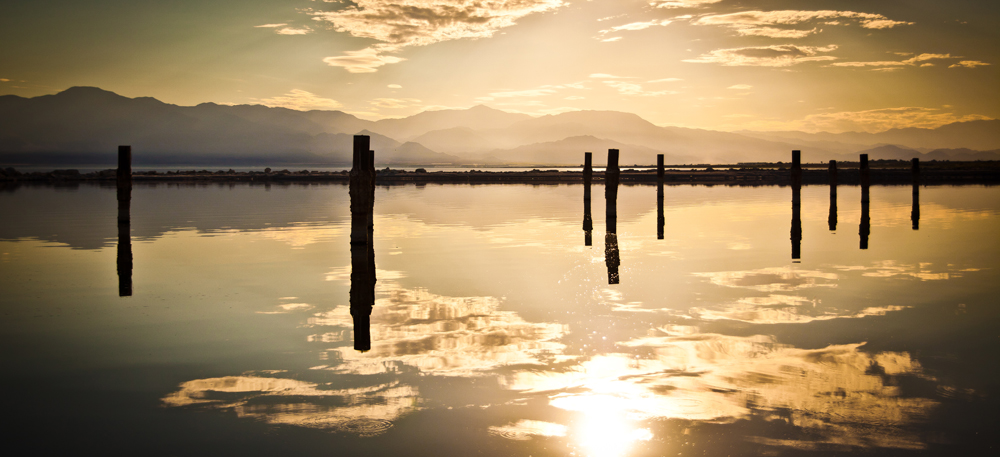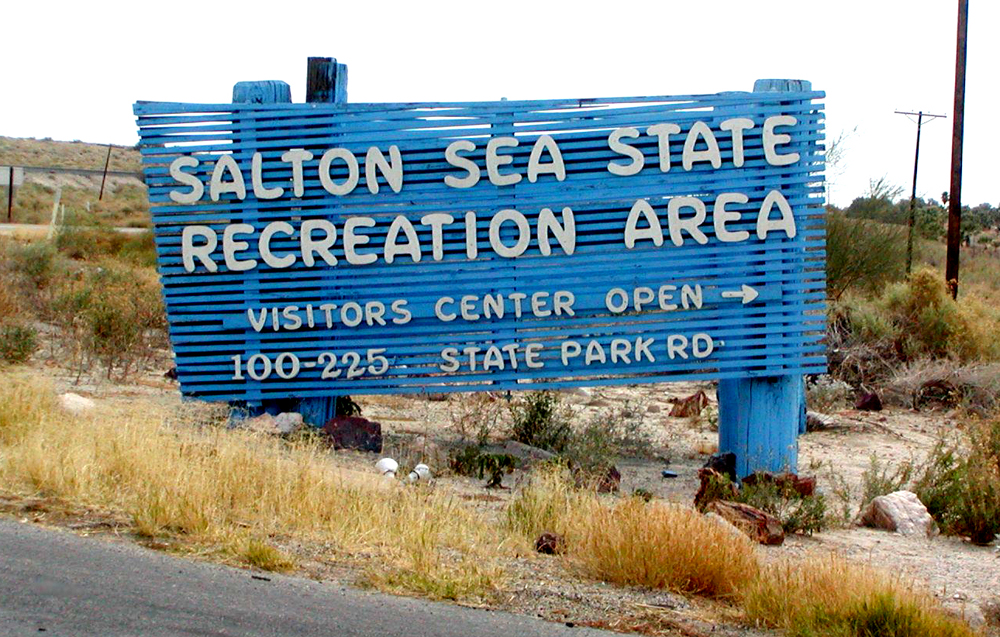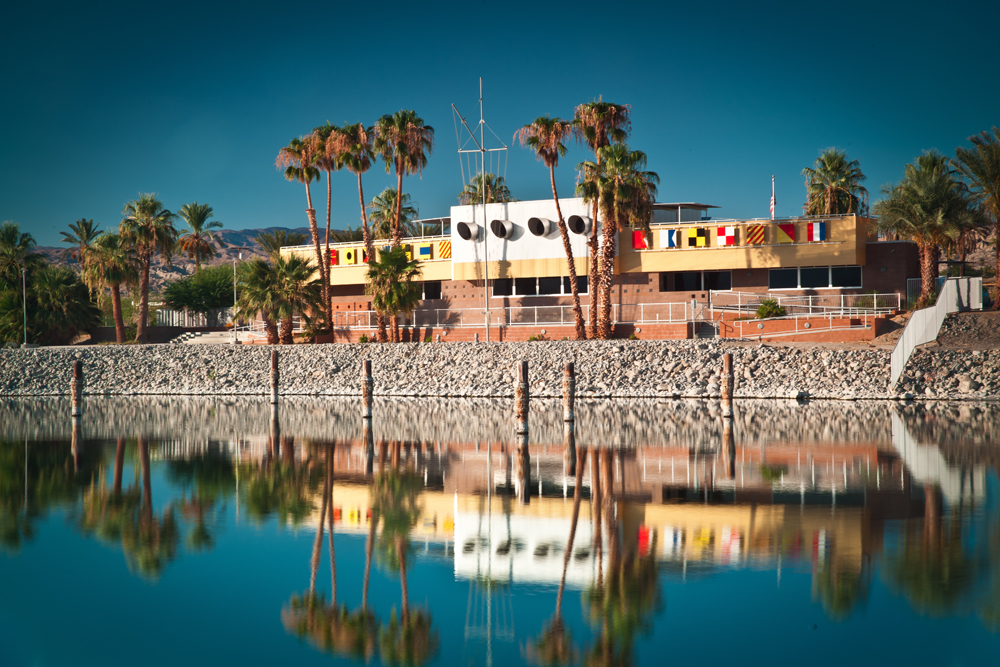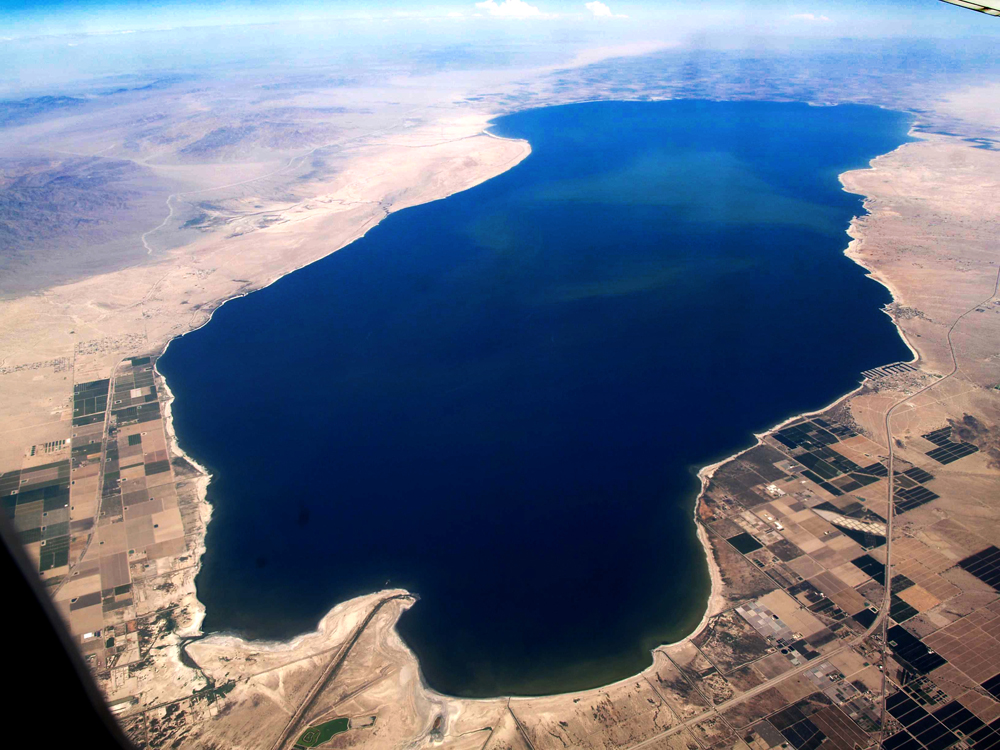By H. Simmons
What if you could be at the sea in less than an hour, where there is no traffic or crowds and it’s easy to park? Wouldn’t it be great to kayak, jet ski, water ski or sailboard on glassy water? How about swim, scuba dive, fish or just relax on the beach?
If you are not a water person, maybe you would prefer to stroll a native plant garden, visit a wildlife refuge, mud volcanoes or bat caves, all while enjoying the wide-open expanse of sea and sky. Why not take in the incredible mountain vistas and watch a spectacular sunset? These favorite sun and sea activities, plus a lot more, can be done all in one place right here in the valley.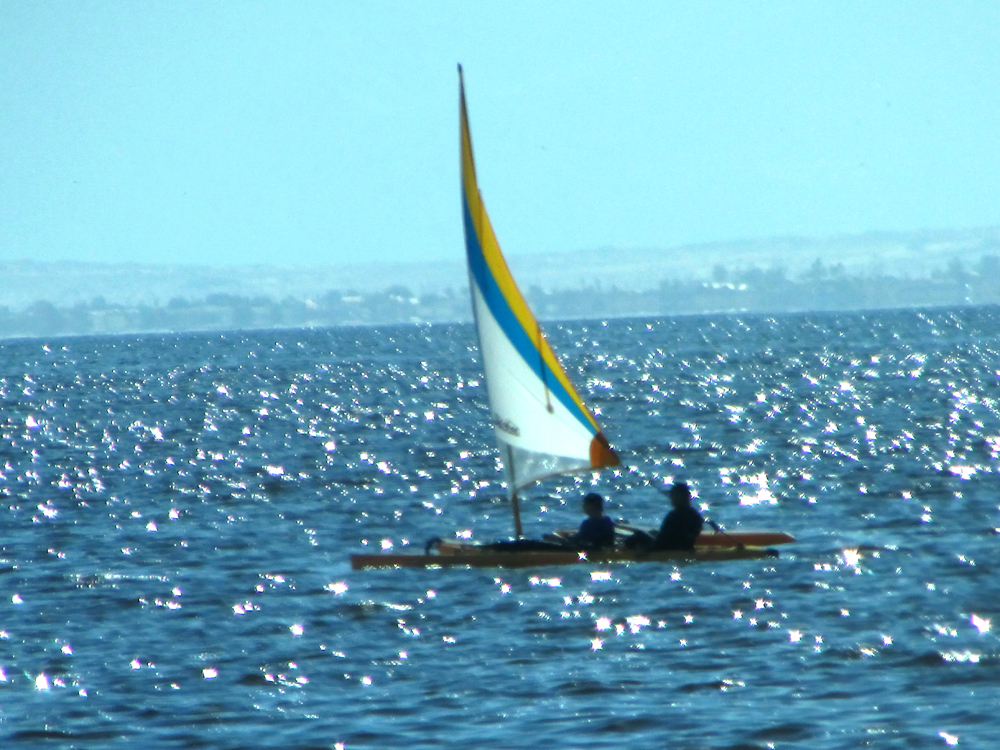
Can you guess where? The Salton Sea. That’s right. This is the Salton Sea State Recreation Area. Have you visited? Consider what you really know about this location before you cast aspersions on this amazing place. In fact, how about you give it a try? After all, it is in your back yard and it’s time as a CV resident that you see it for yourself.
The Salton Sea is the largest body of water in California, so it is not hard to find. Drive to the southeast edge of the Coachella Valley just off Highway 111 and you cannot miss the sun glinting on the sea’s surface. Clear signage will direct your route. Just for a day, leave behind the manicured desert terrain, concrete overpasses and tidy fast food places and venture out where the population dwindles and the desert expands.
Soon the sepia tones of the desert sands become bright green variegated fields of melons, peppers, grapes and date palms. The agricultural farms are a beautiful juxtaposition against the mauve and umber mountains in the near distance. Then there is the water, a bold blue horizon, gentle and vast.
Here you start to get a giddy feeling of adventure. It is as if you have entered a time warp and are privy to the Coachella Valley fifty or more years ago. It is a vision of what our valley must have been like before we defined, domesticated and tamed our desert.
When you pull in, there is a friendly baby-blue wooden slatted welcome sign with white letters that has been nicely maintained since the fifties. Pass the entrance and around the bend is the Visitor’s Center. It is a newer building, inviting and open, filled with information, books and gifts. The large, more modern cement relief state park sign, reminds visitors it is a part of a bigger, beloved California park system and not lost or forgotten. Yet.
Although many of us who dwell here, sadly and unwittingly, wrote-off the Salton Sea as a man-made disaster beyond repair, there are those who have never abandoned this treasure and have always appreciated its potential. They are the Sea and Desert Interpretive Association (SDIA). A non-profit organization established in 1977, their function is to promote educational and interpretive activities to restore, preserve and protect the unique natural and historic values of the Salton Sea. And they do it with a passion and dedication that is inspiring.
In fact, the Salton Sea State Recreation Area remains a viable park today because of their efforts. In 2011, they signed a Donor Agreement with the California Department of Parks and Recreation to raise money to keep the State Park off the state’s closure list.
Through their humble programs and fundraising they have kept the park open. And they do it with only one paid employee. There are eight people on the board. A total of 120 people and organizations are on the list of supporters. Their mailing list is only 150. These devoted souls committed to — and raised — $120,000 this year to ensure the Salton Sea could continue to enchant for at least another year.
Radio and television personality Francoise Rhodes joined the SDIA board in July. “The desert is fortunate to have such a wonderful body of water at our disposal. I am honored and ready to accept the challenge of helping to bring locals and visitors back to the Salton Sea,” said Rhodes.
After living on the California coast for twenty years, Rhodes has an appreciation for our inland sea. “I want to get people involved and enjoy what we have. So many people live in the past. They think of the fish and bird die-offs and they’re not considering what’s here now,” said Rhodes. “I believe there is enough clout and pull in this valley that together we can maintain and preserve the Salton Sea.”
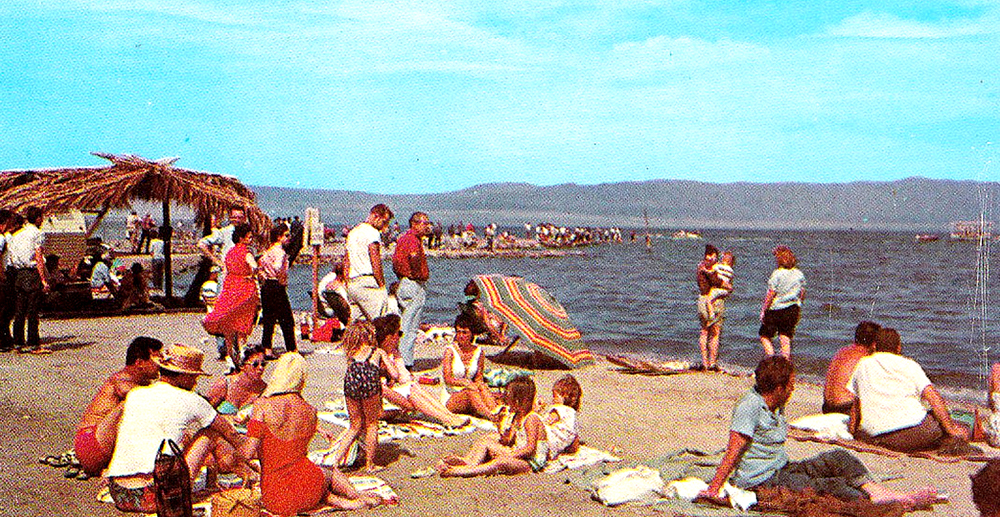 In its heyday, circa mid 1950s and into the late 60s, the Salton Sea was the most popular recreation destination in California. Yes, you read that right. It had more visitors than Yosemite Valley and Lake Tahoe. Essentially — and ironically — the sea and park remain much the same.
In its heyday, circa mid 1950s and into the late 60s, the Salton Sea was the most popular recreation destination in California. Yes, you read that right. It had more visitors than Yosemite Valley and Lake Tahoe. Essentially — and ironically — the sea and park remain much the same.
The Sea is 33 miles long and 13 miles wide. It covers approximately 376 square miles, that’s bigger than Tahoe and Mono lakes put together. It is 232 feet below sea level. Its salinity is 44 parts per thousand compared to the Pacific Ocean, which is 35 ppt. Utah’s Salt Lake is 280 ppt; Israel’s Dead Sea is 210 ppt. The Salton Sea’s salinity makes it the fastest body of water for speedboats. At its deepest it is only 50 feet.
Once there were fifteen boat launches around the sea, now there is only one remaining — at the park’s headquarters. There were 20 different types of fish, now there are two — Tilapia and the indigenous Desert Pup Fish. There were luxury resorts and a championship golf course, now there are only campgrounds — five areas with a total of 475 sites, some with full hook-ups and some simple and primitive.
The State Park has seven full time employees, two seasonal employees and over 40 volunteers. It is patrolled regularly by the State Park Rangers, and is safe and clean.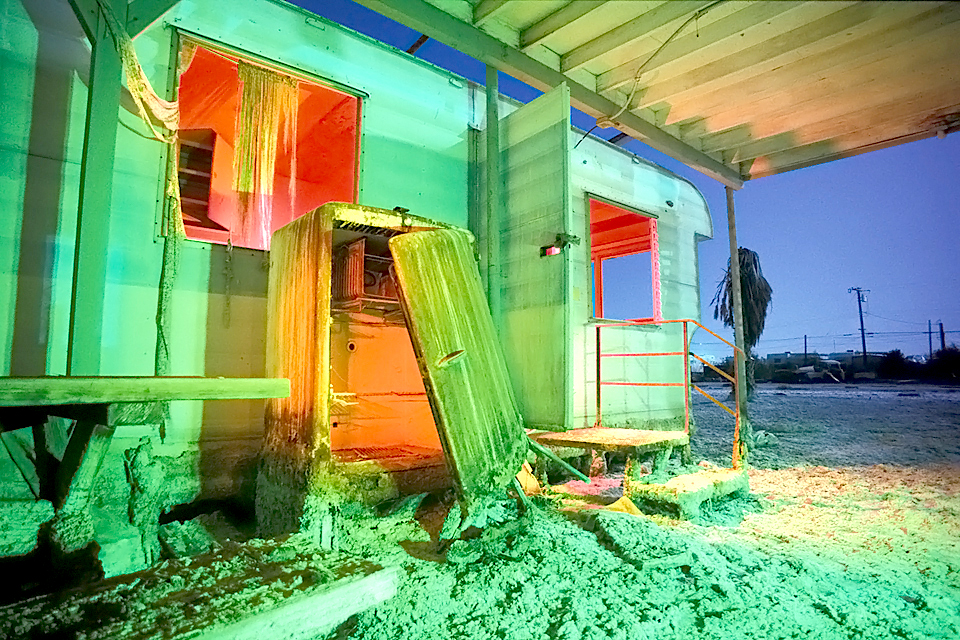
Perhaps you have heard the rumors of sunken neighborhoods, planes and galleons. These rumors are true! Just below the surface is a community of homes. Treetops and telephone poles break the water’s surface marking the exact location. Only recently discovered, there are 32 World War II bombers submerged at the north end of the sea. Records indicate there is a Spanish galleon although it has yet to be located. It could be in the water or under the nearby desert sand.
There are remnants and ruins around the sea and park from bygone days. The dilapidated buildings and rusted-out trailers are far more fascinating than decrepit. The whole area is extremely photogenic. The decay is provocative and interesting, hardly an eyesore, more like installation art pieces. Each place has a narrative, whispers a story.
The Sea and Desert Interpretive Association is dedicated to keeping the Salton Sea’s story alive. Part of that story is to bring back the joy of the Salton Sea State Recreation Area.
This Saturday, September 7, a California no license required fishing derby will be held. There are no limits to how much you can catch. And it shouldn’t be difficult to get a bite. There are an estimated 400 million Tilapia in the sea. There is a designated cleaning station. It was reported that a four-pounder was caught at the last derby. Yes, the fish are edible. Although, it is important to mention, as with all fresh fish, the Federal Drug Administration (FDA) recommends that only six to twelve ounces of fish should be consumed a week when caught by family and friends from rivers, lakes and coastal areas.
October begins the Salton Sea Discovery Kids Camp where kids ages seven and up get to camp overnight and earn badges in water safety, kayaking, tracking and learning about local wild life and will include a Junior Ranger program. Graduation night includes a smores badge.
Next year, January 25 and 26 is the Pelican Days Festival. March 22 is the Wind and Water Sailing Regatta and Kite Festival. Every Sunday there is a free interpretive kayaking tour. You must make reservations in advance but it includes the kayak, single or double, life vest and knowledgeable guides. No experience necessary and donations are accepted to help keep the program going.
Currently the SDIA is sponsoring a Wildlife Photo Contest. Two categories: one for ages 16 and under, and 17 and up. The only requirement is that the photos must be of Salton Sea wildlife. The contest ends December 1. This is more challenging than you may think. It is hard to take a bad picture of this visually stunning area. So the competition may be tough.
The Salton Sea is an important wildlife habitat. It has the second highest count of different species in the nation! It is noted as California’s crown jewel of avian biodiversity. The sea is a critical stop for migrating birds along the Pacific Flyway. Just to see the beautiful birds is worth the drive. Varieties of pelicans, herons, storks, grebes, ducks, rails, ibis, terns and the endangered clapper, to name a few, call the Salton Sea home. Seeing the diversity of fowl poke at the shoreline, wade on the water, pose on a pylon or fly along the surface is exhilarating. The birds appear relaxed, wise and comfortable, sharing their precious sea and its resources.
Not everyday is a perfect day at the sea. Sometimes there are flies from the nearby fields, some days it can be very windy and some times it can emit an odor. With such a huge fish population, it is not uncommon to see dead fish. But by far, there are mostly beautiful days. Even the Pacific Ocean has days with flies, smells and too much wind. But with only a short drive to the Salton Sea, even if the water isn’t great due to an algae bloom, there are wonderful surrounding desert adventures and activities.
When you stand on the shore of the Salton Sea, it is hard to image that someday it could be gone. There is no question that this would be an environmental disaster. It is a very real possibility and a looming threat.
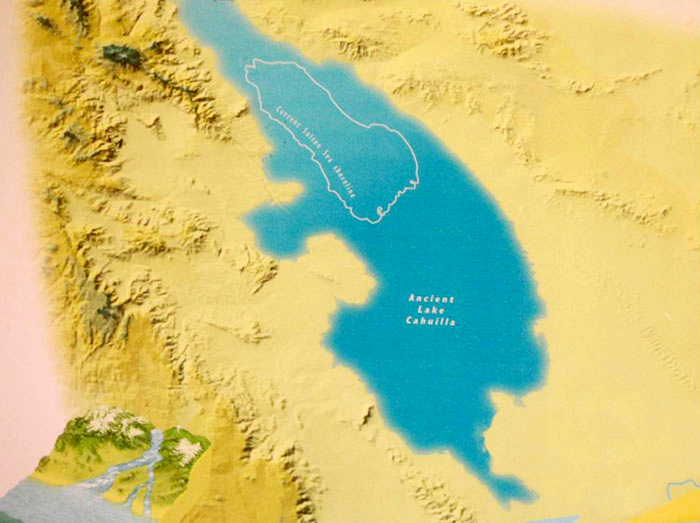 The Salton Sea is not man made. It is what remains of an ancient inland sea. Water levels can still be seen on the nearby mountains. (It is believed the word “Coachella” came from a misunderstanding of the Native American word for “seashells” which were found in abundance on the valley floor.) Over the centuries the sea would fill and drain to new highs and lows.
The Salton Sea is not man made. It is what remains of an ancient inland sea. Water levels can still be seen on the nearby mountains. (It is believed the word “Coachella” came from a misunderstanding of the Native American word for “seashells” which were found in abundance on the valley floor.) Over the centuries the sea would fill and drain to new highs and lows.
In 1540, the Spanish sent an expedition up the mouth of the Colorado River from the Gulf of California.
The sea evaporated in 1891. Early on the sea was referred to as the Salton Sink. Getting its name from a nearby salt mine.
Before a canal controlled the Colorado River, the sea was part of the Colorado River Delta, which regularly flooded delivering nutrient rich soil to the Coachella and Imperial Valleys.
In the early 1900s water from the Colorado River was intentionally diverted and accidentally refilled the Salton Sink creating today’s Salton Sea. The fledgling agriculture industry saw the value of the sea for irrigation and run-off needs. Their relationship forever entwined.
It was a tropical storm in the late 1970s that raised the sea and flooded the neighborhood now underwater.
Human intervention has impacted and contributed to the Salton Sea’s existence and problems.
Today the sea has no constant fresh water inflow, nor is there an outlet. The only source of water is rain — which on average is less than three inches a year — and agricultural irrigation runoff from the Coachella and Imperial Valley. The sea loses six to eight inches a year through evaporation, which causes the salinity to rise and threatens fish populations and impacts the birds that feed on them.
The nutrients from fertilizers play a part in the life cycle of the sea both good and bad. Nitrates and phosphates stimulate the growth of algae and phytoplankton, which supports zooplankton and worms that feed the fish. These nutrients settle below the sand at the bottom of the sea. Scientists think it is the nutrients that periodically cause the odor. High winds may stir the water and sand releasing a smell. These nutrients also contain salts.
Our high temperatures can affect the sea’s algae blooms. When the algae dies, oxygen levels lower, which can cause fish die-off. If the Salton Sea were to disappear tomorrow, not only would the wildlife habitat be severely impacted but valley residents could experience health issues from exposure to a dry and dusty chemically laden sea floor.
According to the Salton Sea Authority, there are no significant toxic levels in the sea and not a single bird has died from pesticides at the sea itself. Scientists continue to monitor the levels of toxins as part of the restoration. The water is said to be safer than the ocean.
There are many groups and organizations working to find a solution to save the Salton Sea. It is a complex issue with no simple answer. More study must be done to manage and sustain the Salton Sea ecosystem. These problems are significant and the sea and abundant life deserve our attention.
“The best way to get involved is to enjoy the Salton Sea,” said Connie Brooks, Management Consultant for the Sea and Desert Interpretive Association. “There are so many fun and interesting things to do here.” Brooks has been active with the organization for over four years, first serving on the board and one year at her present position.
Her positive outlook and enthusiasm is genuine. When she’s not writing grants or raising funds or scheduling events, she loves to kayak on the sea. Brooks lives at the park five days a week. She tries to post a picture everyday on the Association’s Facebook page. If you are interested in sponsoring a live web cam, Brooks would love to talk with you. When you call Brooks, she answers, “It’s a beautiful day at the Salton Sea.” And she means it.
Right now, the biggest challenge the Salton Sea has is combating the misconceptions of CV residents. Isn’t it time we take ownership and ensure the Salton Sea is part of our future?
Contact the Sea and Desert Interpretive Association at 760 289-9455. For camping reservations, park fees or general information about the Salton Sea State Recreation Area visit the California Department of Parks and Recreation website at www.parks.ca.gov

































